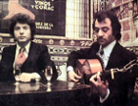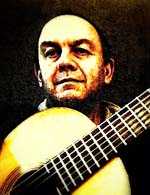Welcome to one of the most active flamenco sites on the Internet. Guests can read most posts but if you want to participate click here to register.
This site is dedicated to the memory of Paco de Lucía, Ron Mitchell, Guy Williams, Linda Elvira, Philip John Lee, Craig Eros, Ben Woods, David Serva and Tom Blackshear who went ahead of us.
We receive 12,200 visitors a month from 200 countries and 1.7 million page impressions a year. To advertise on this site please contact us.
|

|
|
RE: Where to get an 8 string flamenco guitar?
|
You are logged in as Guest
|
|
Users viewing this topic: none
|
|
Login  | |
|

   
estebanana
Posts: 9351
Joined: Oct. 16 2009

|
 RE: Where to get an 8 string flamenc... (in reply to Ricardo) RE: Where to get an 8 string flamenc... (in reply to Ricardo)
|
|
|
quote:
I am more traditionalist like you, but honestly the 33% is not right as majority of the time we are "adding" bass strings to the guitar and those strings tend to be essentially 6th strings tuned down in pitch with significantly reduced tensions. If we add a higher string then, more often, a high E would break long before compromising the guitar itself (In my experience).
The added tension is not measured in percentages, it is measured in pounds of pressure. You can't do the tension to structure calculation work in the design unless you have hard numbers on string tension. And you are correct Ricardo being that lower tension basses are added, the guitar can sustain the added tension without much modification. The average Conde' with a slightly thicker top can handle it fine. The real place it needs the bit of help is the first transverse brace above the sound hole. That one needs to be beefy to keep the neck body connection integrity, it takes a lot of loading. And the neck itself is important, but with carbon fiber spars the neck can be fabricated to remain stiff and straight.
Adding one lower bass on a seven string, I use d'Darrio silver overwound 0.54 or 0.56, creates an average of 15 lbs of added tension when tuned between D and low C, tuning to low B or A is possible, but at that low pitch the string is not adding significant loading to the bridge. The general rule is, as pitch goes down and string diameter goes thicker, tension drops. One string at 0.56 tuned to D or lower and distributed over the bridge through the top, using carbon fiber and making the transverse bar robust you can safely leave the top graduations the same as any medium built flamenco guitar. And adding two basses increases the loading by double, but again it is moderated by the pitch and string diameter as well as being distributed by the bridge. You have to find out the numbers in pounds of pressure and make calculations based on the strength of the woods you'll be using and the bracing design.
Speaking of tuning, a flamenco or any intended use extended range guitar with 7 to 10 strings could also use a kind of 'reentrant' tuning. Many ten string players use one of several type of reentrant tuning schemes.
Here: http://en.wikipedia.org/wiki/Reentrant_tuning
Yepes tuning: http://en.wikipedia.org/wiki/Ten-string_classical_guitar_of_Yepes#Tunings
You can study those Wiki entries and see that tunings do not always descend in regular diatonic order, they can be broken into many different combinations of chromatic, diatonic and reentrant possibilities. Tuning orders are a source of never ending discussion for extended range guitarists when they talk about how to match a tuning to a certain piece they want to play, like piano transcriptions. Or how different tunings effect the overtone production of a particular instrument, or even for composing where the composer wants to utilize specific pedal tones, etc.
The famous 'Brahms Guitar' designed by David Rubio for Paul Galbraith is an extended range guitar with 8 strings which was designed to sustain a low A string and be able to play piano transcriptions. We have to remember David Rubio began as a flamenco guitarist, then a flamenco guitar builder and then he eventually became a violinmaker. So if you have an inclination to use an extended range guitar, maybe your own musical compass is being limited by the genre of flamenco and you need move outside. Sometimes we don't see that life is about making connections to the next thing and instead we grasp to make something work in the wrong genre, musically speaking. If you are drawn to a certain sound of instrument and it does not fit cleanly into the genre you are working in then you have the choice to follow the sound and transcend the genre, or let that go and deepen your roots in one genre. Both ways are legitimate ways to grow. I have seen players contemplate taking on extended range guitars and these questions arise over and over. You can only answer them for your self.
You can also experiment with reentrant tunings on your present six string guitar. That may not be a practical way of doing flamenco, but if you think back to the Baroque guitar where there is still a lot of rasgueado in the music, you can consider that it uses a form of reentrant tuning. The rasgeo and the reentrant tuning are historically concurrently played. This may not be regular flamenco tuning, but in experimenting with non standard tunings you may learn more about chord voicing in standard tuning. It's my understanding that many of the flamenco guitarists we know at the top of the game have used non standard tunings and have gone back and forth between standard and non standard and moved falseta material over the tuning borders.
As far as longevity of extended range guitar structures I did some research work on that. I calculated the string tensions and then did the cross referencing with some makers who had practical experience over a period of more than 30 years with extended range guitars and everyone agreed that is was a workable plan at tensions I found to create a flamenco structured seven string. And I have built four of them to date and all were very successful and are being played by customers who are pleased with them. The fifth as I mentioned is classical and the top and braces reflect a more structured top. That guitar does not have a flamenco sound or feel as is was made with a stiff modified lattice structure. It does have a sweet sound, amazing intonation and no wolfy notes. It was made for a composer to record his own music with.
I'm mentioning these things to clear up misconceptions that people seem to have about the structures and the potential of extended range guitars whether they intend them to be for flamenco, jazz , bossa nova-choro, or classical music. They do not have to be over built if they are strengthened in the key areas I cited.
The Chinese are making ten string and other extended range guitars and you can also get a factory made 7 string from Brazil, they are almost all chunky and heavy, which I suspect is because a factory made guitar is not as finely calibrated as a hand made guitar. I have studied those guitars and determined they are over built. My aim was to create a high performance guitar with an extended range that was built to the edge of a performance maximum while still structured to last more than a lifetime. I think I did pretty good. And to date I don't recall another makers who frequent the Foro except for Stephen Eden and Jorge who have made any extended range guitars. The later man Jorge asked me for a consult in designing his model and it came out very nice. When someone makes and sells more extended range flamenco guitars than I have and does more research than I have, I'll take advice from them.
On the other hand, I still like six string guitars and always have, but I'm not here to put guitar players in jail by saying this or that is not possible. I have never supported that kind of attitude even though I generally have a bad attitude about a great many things. I'm just a bitter old fart, but allowing players to make the kind of music they need to make is not one my attitude problems.
_____________________________
https://www.stephenfaulkguitars.com
|
|
|
|
REPORT THIS POST AS INAPPROPRIATE |
Date Dec. 17 2014 0:13:39
 |
|

   
estebanana
Posts: 9351
Joined: Oct. 16 2009

|
 RE: Where to get an 8 string flamenc... (in reply to Guest) RE: Where to get an 8 string flamenc... (in reply to Guest)
|
|
|
quote:
So what type of "tension to structural calculation" work do you do during the design stage? I am curious.
When you say 'pounds of pressure' that can actually be interpreted as psi (or pounds per sq. in.) since it's a common way to refer to it. That's why I thought it was worth clarifying. These are not my terms by the way, it's called Physics.
I used two of the methods I picked up in this book, and I framed an experiment around existing instruments with extended range stringing that I knew to be of certain age, have a known number for pounds of tension pulling on the bridge, and accurate top thickness and brace size data.
The book is Left Brian Lutherie. http://www.ukuleles.com/LBLBook/TOC.html
Ways to calculate things such as how many square inches of foot print a bridge needs to be glued secure at a given string tension are given. What I did was take the data I collected from my sample group of instruments, and compared the tension loading to the structure size and strength by direct intuitive observation and measurements then double checked a few things using what I knew about top thicknesses and string tension in the samples. It was not difficult to determine that the primary sample was over built or that it would be reasonable to build a copy of it with less massive supporting structure under the top.
Then I offered my hypothesis and conclusion to two other full time luthiers, both of whom gave sample instruments to observe along with the top thicknesses etc. and they yes this looks valid. Both the luthiers I asked to check my work were experts in math, but neither of them used math to check my idea. They knew through experience that my conclusion was valid and said I was safe to go forth if I used the structure parameters I described.
So I basically took the formulas I needed from the LBL book ( below) and just checked a couple things, and the rest was a lot of comparative analysis and measuring of structure between a really heavy over built instrument which I was commissioned to copy, and a light instrument and several degrees of structure in other instruments that I thought was between them. After I realized the instrument to be copied was more massive than it needed to be I set up a new schedule of dimensions in braces based on the comparative observations. Then I built the first instrument with structure significantly lighter than the object that was to be copied, but left the top thickness the same as a normal flamenco guitar. Then after the guitar was strung up, it did not fold up on itself or develop an 'S' shaped stress distortion in front of the bridge; 'S' distortion happens when the bridge is rolling or pitching forward because the top can't stand the pressure shearing down on the saddle and it digs the front end of the bridge into the top. And the bridge did not separate from the top due to glue failure set up by having to too small a foot print.
After that is was a matter of staying within the structure that I thought would work and had tested by building it. Each successive time I built that model I was even able to take little more out of the structure, but by that time it was all intuition informed by practical experience.
Essentially right from the start my intuition told me to go lighter, but before I risked a whole guitar I double checked by observing existing instruments along a range of structures, then rechecked a few details using David Hurd's calculations, then had my work checked by two older dudes who already did everything I had done, but 30 years before me. I suppose that is not mathy smart engineering, but it worked. I would call it 'vernacular engineering'.
My dad used to tell his friends that I should have been an engineer because I've always had an intuitive feel for it. My teachers in college tried to steer me into it too, but for some reason I resisted. They observed the same knack for feeling how structures should work. So even though I don't use physics as an engineer would to make a bridge between shore and an island I'm hard wired to look at life that way and guitar making offers safe intuitive ways to work out the problems. I am really interested in vernacular architecture, which is a very culturally based and intuitive subject, so I've come to see guitar making as vernacular engineering as I see a direct correlation.
Some may not be familiar with the term vernacular architecture, but if you read the Wiki definition and gist out how it relates to guitar making it might make sense. I kind cringe when the two discussion topics come up. They each drive me nuts, one is 'guitar making- art or science?' the other is when literal physics related ideas are rigidly demanded as explanations of how guitars work. The reasons they make me crazy is that the second one is very much fear based and the later topic always ends in the dullest elliptical arguments and never resolve. If guitar making could be discussed as a specialized form of engineering, like calling it Folk engineering or exactly what I believe it to be, vernacular work, it might be more fun. http://en.wikipedia.org/wiki/Vernacular_architecture
Just my added two cents on the non existential part of guitar making. You don't want to hear what I have to say about guitar making, Freud and existential writers as a counter point to the cool of engineering, but they are related.
_____________________________
https://www.stephenfaulkguitars.com
|
|
|
|
REPORT THIS POST AS INAPPROPRIATE |
Date Dec. 18 2014 13:04:08
 |
|
 New Messages New Messages |
 No New Messages No New Messages |
 Hot Topic w/ New Messages Hot Topic w/ New Messages |
 Hot Topic w/o New Messages Hot Topic w/o New Messages |
 Locked w/ New Messages Locked w/ New Messages |
 Locked w/o New Messages Locked w/o New Messages |
|
 Post New Thread
Post New Thread
 Reply to Message
Reply to Message
 Post New Poll
Post New Poll
 Submit Vote
Submit Vote
 Delete My Own Post
Delete My Own Post
 Delete My Own Thread
Delete My Own Thread
 Rate Posts
Rate Posts
|
|
|
Forum Software powered by ASP Playground Advanced Edition 2.0.5
Copyright © 2000 - 2003 ASPPlayground.NET |
0.078125 secs.
|


 Printable Version
Printable Version









 New Messages
New Messages No New Messages
No New Messages Hot Topic w/ New Messages
Hot Topic w/ New Messages Hot Topic w/o New Messages
Hot Topic w/o New Messages Locked w/ New Messages
Locked w/ New Messages Locked w/o New Messages
Locked w/o New Messages Post New Thread
Post New Thread